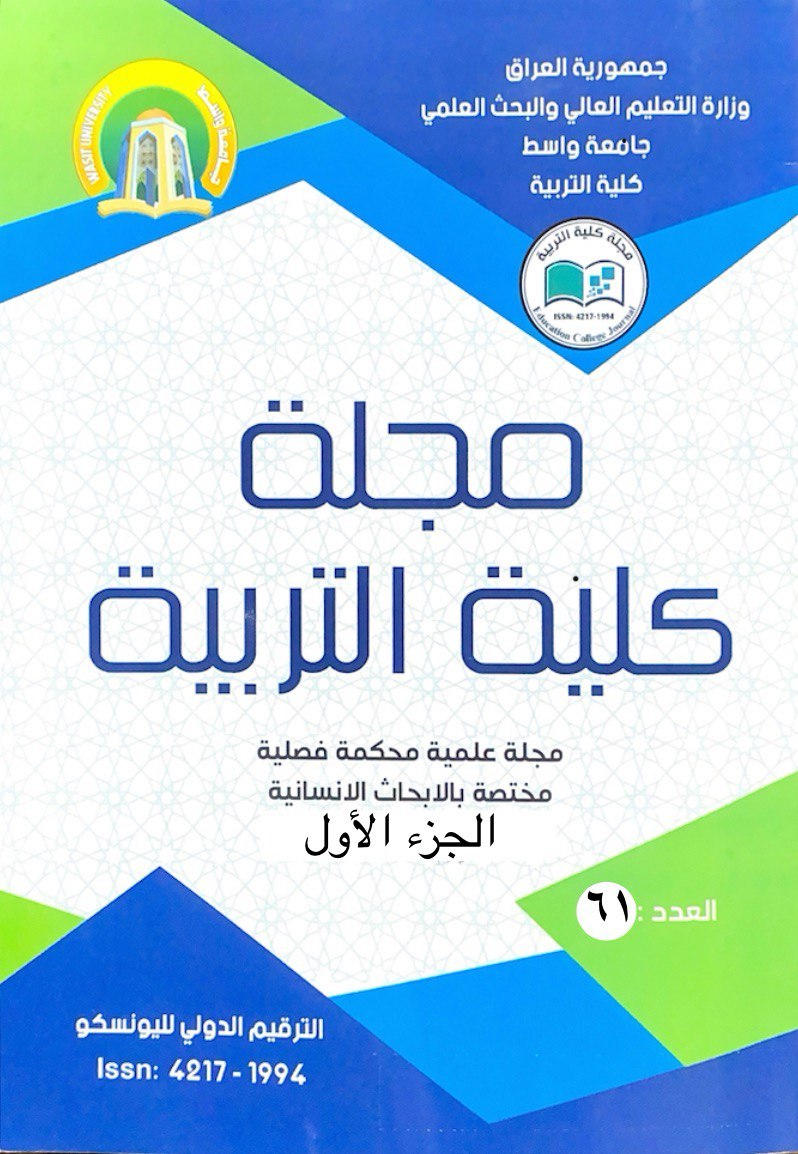Holy Places in the Holy Qur’an (Makkah as a Model)
DOI:
https://doi.org/10.31185/eduj.Vol61.Iss1.4593Keywords:
Sacred Places - Holy Quran - Mecca - Kaaba - Geography of the SacredAbstract
This study examines the topic of sacred places in the Holy Quran, taking Mecca as a model for research and analysis. The study derives its significance by highlighting the special status that the Holy Quran bestows upon sacred places in general and Mecca in particular, along with the associated legislations and rulings that reflect their importance in the Islamic system. The research aims to explore and analyze how the Holy Quran addresses sacred places, specifically Mecca, through studying the Quranic verses related to it and addressing the epistemological, legislative, and civilizational dimensions of this sacred place, with the goal of reaching a deeper understanding of the relationship between sacred space and Islamic legislation. The research employed a descriptive-analytical methodology, through the induction and analysis of Quranic verses related to Mecca, while utilizing the deductive approach to extract the epistemological and value implications associated with sacred space. A comparative approach was also employed to highlight the uniqueness of Mecca among other sacred places. The research relied on diverse original sources including books of exegesis, hadith, jurisprudence, and history, alongside contemporary studies related to the research topic. The study concluded that: the Holy Quran establishes an integrated theory of "sacred geography" that transcends the purely devotional dimension of sacred places to establish a comprehensive civilizational model; there exists a dialectical relationship between sacred space and Islamic legislation, manifested in the specificity of rulings related to the Sacred Sanctuary (Haram), particularly the prohibition of hunting, which establishes the concept of "spatial coexistence" encompassing humans, animals, and plants; the Holy Quran presents a unique model in dealing with sacred space that goes beyond the traditional understanding of sacredness as merely geographical designation, to establishing the concept of "civilizational space" that reflects Islam's vision of the relationship between humans, place, and time; the establishment of the concept of "comprehensive security" in sacred space to include all beings, which establishes an advanced environmental model in dealing with sacred space, achieving environmental balance and protecting biodiversity; the study reveals the close relationship between sacred space and Islamic identity, through the Holy Quran's designation of the Kaaba as the direction of prayer for Muslims and a symbol of their unity and civilizational belonging.
Downloads
References
القرآن الكريم
المصادر العربية
1. ابن الأثير، المبارك بن محمد الشيباني. (1979). النهاية في غريب الحديث والأثر. تحقيق: طاهر أحمد الزاوي ومحمود محمد الطناحي. بيروت: المكتبة العلمية.
2. ابن الجوزي، جمال الدين أبو الفرج عبد الرحمن بن علي. (1997). فضائل القدس. تحقيق: جبرائيل سليمان جبور. بيروت: دار الآفاق الجديدة.
3. ابن الظهيرة، محمد بن عبد الله. (2012). الجامع اللطيف في فضل مكة وأهلها وبناء البيت الشريف. تحقيق: علي عمر. القاهرة: مكتبة الثقافة الدينية.
4. ابن عطية الأندلسي، عبد الحق بن غالب. (2001). المحرر الوجيز في تفسير الكتاب العزيز. تحقيق: عبد السلام عبد الشافي محمد. بيروت: دار الكتب العلمية.
5. ابن منظور، جمال الدين محمد بن مكرم. (1993). لسان العرب. بيروت: دار صادر.
6. الأزرقي، أبو الوليد محمد بن عبد الله. (2003). أخبار مكة وما جاء فيها من الآثار. تحقيق: رشدي الصالح ملحس. بيروت: دار الأندلس.
7. البروجردي، حسين الطباطبائي. (1992). جامع أحاديث الشيعة. قم: المطبعة العلمية.
8. الحكيم، محمد باقر. (1996). علوم القرآن. قم: مجمع الفكر الإسلامي.
9. الرازي، فخر الدين محمد بن عمر. (1981). التفسير الكبير (مفاتيح الغيب). بيروت: دار الفكر للطباعة والنشر والتوزيع.
10. الراغب الأصفهاني، الحسين بن محمد. (2009). المفردات في غريب القرآن. تحقيق: صفوان عدنان الداودي. دمشق: دار القلم.
11. الصباغ، أحمد بن محمد المالكي. (1994). تاريخ أمراء مكة المكرمة. تحقيق: عبد الله بن دهيش. مكة المكرمة: مكتبة الأسدي.
12. الصدوق، محمد بن علي بن بابويه. (2006). علل الشرائع. قم: منشورات المكتبة الحيدرية.
13. الطباطبائي، محمد حسين. (1997). الميزان في تفسير القرآن. بيروت: مؤسسة الأعلمي للمطبوعات.
14. الطبري، محمد بن جرير. (2000). جامع البيان في تأويل القرآن. تحقيق: أحمد محمد شاكر. بيروت: مؤسسة الرسالة.
15. الفاسي، تقي الدين محمد بن أحمد. (2000). شفاء الغرام بأخبار البلد الحرام. تحقيق: عبد الملك بن عبد الله بن دهيش. مكة المكرمة: مكتبة الأسدي.
16. الفاكهي، محمد بن إسحاق. (1994). أخبار مكة في قديم الدهر وحديثه. تحقيق: عبد الملك بن عبد الله بن دهيش. مكة المكرمة: مكتبة الأسدي.
17. الفراس، مسعود بن عيسى ورام بن أبي. (1995). تنبيه الخواطر ونزهة النواظر. بيروت: دار التعارف للمطبوعات.
18. الفراهيدي، الخليل بن أحمد. (2003). كتاب العين. تحقيق: مهدي المخزومي وإبراهيم السامرائي. بيروت: دار الكتب العلمية.
19. الفيروز آبادي، مجد الدين محمد بن يعقوب. (2005). القاموس المحيط. تحقيق: مكتب تحقيق التراث في مؤسسة الرسالة. بيروت: مؤسسة الرسالة للطباعة والنشر والتوزيع.
20. المجلسي، محمد باقر. (1983). بحار الأنوار الجامعة لدرر أخبار الأئمة الأطهار. بيروت: مؤسسة الوفاء.
21. المحمدي الري شهري، محمد. (2011). الحج والعمرة في الكتاب والسنة. قم: دار الحديث للطباعة والنشر.
22. النوري، حسين بن محمد تقي الطبرسي. (1987). مستدرك الوسائل ومستنبط المسائل. بيروت: مؤسسة آل البيت لإحياء التراث.
23. بودالي، بن عون، وأم الخير شتائحة. (2022). المقدس في الإسلام: دراسة تحليلية عند الصوفية. مجلة العلوم الإسلامية والحضارة، 7(3)، 89-104.
24. حاج مالك بن الشيخ داود. (1988). الحقائق الإسلامية في الرد على المزاعم الوهابية. بيروت: دار الفكر.
25. علي، جواد. (2001). المفصل في تاريخ العرب قبل الإسلام. بيروت: دار الساقي.
26. كراتشكوفسكي، اغناطيوس يوليانوفتش. (1987). تاريخ الأدب الجغرافي العربي. ترجمة: صلاح الدين عثمان هاشم. بيروت: دار الغرب الإسلامي.
27. مكارم الشيرازي، ناصر. (1990). تفسير الأمثل في كتاب الله المنزل. بيروت: مؤسسة البعثة.
28. وزارة الحج. (2006). مكة المكرمة عاصمة الثقافة الإسلامية: 3-4 ذو الحجة 1426 هـ. مكة المكرمة: وزارة الحج والأوقاف.
المصادر الأجنبية
29. Meri, J. W. (1999). Aspects of Baraka (Blessings) and Ritual Devotion among Medieval Muslims and Jews. Medieval Encounters, 5(1), 36-67.
https://doi.org/10.1163/157006799x00259 DOI: https://doi.org/10.1163/157006799X00259
Downloads
Published
Issue
Section
License
Copyright (c) 2025 م.د حبيب كاظم خضير الجبوري

This work is licensed under a Creative Commons Attribution 4.0 International License.









